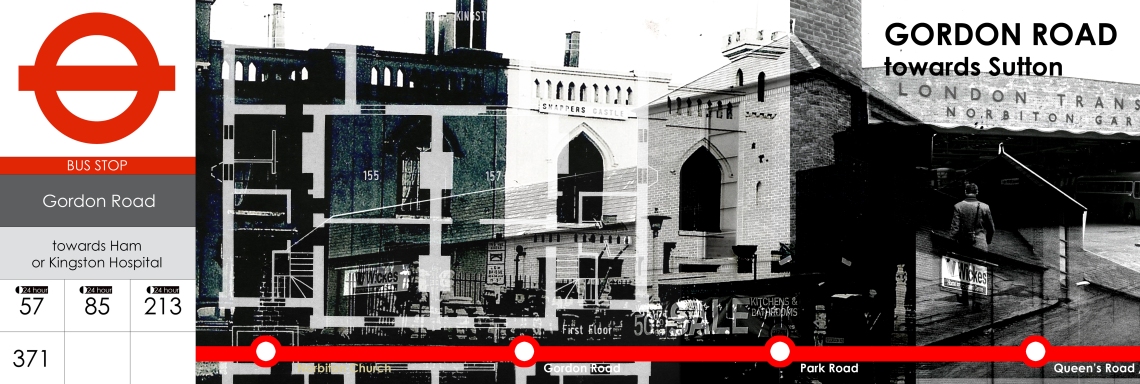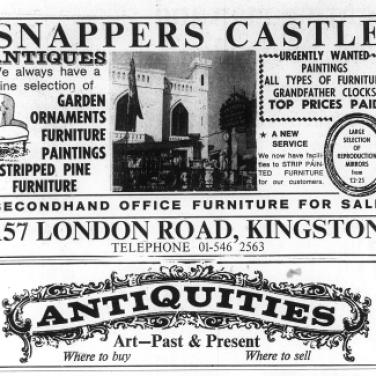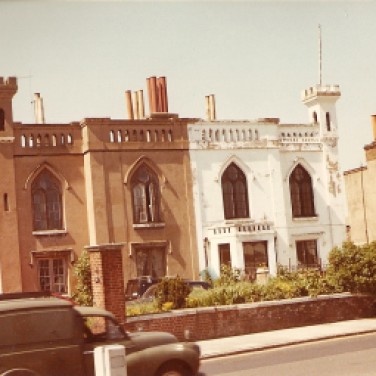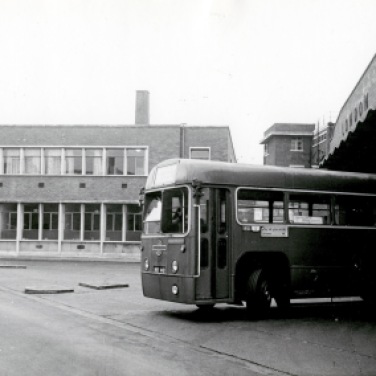
The story of 155-157 London Road, Kingston
The present site of Wickes Superstore was previously Norbiton Bus Garage and before that the site of Snapper’s Castle. Snapper’s Castle wasn’t actually a castle, but its history was really interesting, and Snapper wasn’t a king, dragon or monster, but a man called Michael who sold antiques. The failure of Norbiton Garage is linked directly with the move towards privatisation of public bus services, a move which was not welcomed by passengers or staff at the time and had to be semi-reversed in London at least when it failed to deliver. The following story is one of opportunity lost, of destruction both of material heritage and the livelihoods of some local bus workers.
Hertingtoncombe Manor House
The origin of two semidetached houses on London Road, Nos.155 and 157, with their Gothic facade and roof crenelations date back to the 17th century. In 1644 it was the residence of Sir Robert Wood, a Cromwellian supporter. Later, John Rous resided there – he was sugar plantation owner and a Quaker who was imprisoned and publicly flogged for his beliefs. Later still, a resident called Edward Belitha left money to Kingston Corporation to education “20 poor persons’ daughters”; the chief clark of the House of Commons, Nicholas Hardynge resided there and so too for a time the Reverend Richard Wooddesson, Head of Kingston Grammar School. From 1774 to 1839 it was the Parish Workhouse, extolling virtue, sobriety, obedience, industry and labour upon its residents.
In 1841 it underwent extensive alterations made by Charles Molloy Westmacott, a publisher, art critic and historian who came from a family of sculptors, artists and architects. He installed wood paneling formerly used in Kensington Palace, whilst incorporating many of the earlier buildings’ features and fittings. The ground floor was 2 main rooms split by sliding doors, its facade had oriel windows, elaborately carved oak doors, corner turrets, and 4 tall ecclesiastical windows;. It was successfully listed Grade II in 1975 for architectural and historic interest.
In its final years it was affectionately known as Snapper’s Castle due to the distinctive nature of Michael Snapper’s antiques shop. Meanwhile, next door a local firm of automotive suppliers Derrington’s ploughed their trade.
Norbiton Bus Garage
The garage originally opened in May 1952 on a site behind the Car and Antiques shops on London Road. Its opening wasn’t covered in the local press, but it was big enough for 75 buses and included a maintenance area. Routes 65,131,201, 206, 213 and 264 were based there.
By 1973, the London Transport Executive believed that the only solution to improving bus operations in the Kingston was by expanding Norbiton Garage, for which a Transport Act was granted in 1975. This gave them compulsory purchase powers among other things and they wished to use these powers to demolish Hertingtoncombe Manor. There was local opposition so a public enquiry took place, London Transport versus Kingston Council, Kingston Society, Kingston upon Thames Archaeology Society, Surrey Archaeology Society, and the Ancient Monuments Society, with the additional backing of the Greater London Council. The arguing was extensively covered in the local press, but in the end, London Transport won out. In giving permission for the demolition, Mr John Eyre, Inspector for the Department of the Environment who conducted the public enquiry stated that “the public good would best be served by a better transport system”. The site was eventually cleared in 1978, but then in 1980 plans for the garage were shelved and the site left derelict.
Eventually, Norbiton Garage extension was built and opened officially on 13th January 1984 (and for operations the following day). It had accommodation for a fleet of 115 vehicles, and 400 staff over three areas – an operating block with workshops, administration, lockers, WCs, a games room and canteen (for 56 people at a time), a dock area and ancillary block. Kingston Garage remained in use as a station for passengers. It had cost £4.6 million and the Brick Bulletin No.1 of 1985 wrote that is featured “a textured facade of considerable dignity”, it was also described as ‘the jewel in the crown of the London Bus Service’. Grade II listing hadn’t saved the Manor House but interestingly, 3 tree preservation orders had to be adhered to and water mains to the south of the site had to be left accessible, severely limiting the layout of the design.
Sadly, Norbiton Garage was shortlived. Everything changed in 1987 when the Conservative government decided to privatise London’s bus services, creating London Bus Ltd, a process of deregulation which is against my own political standpoint and seems to involve running a fairly efficient public service into failure through a lack of investment and by disenfranchising your dedicated workforce (nobody is in the public sector for the money!), offering privatisation up as salvation, a process which I see repeated elsewhere today. London Bus Ltd tendered operations at Norbiton as a lower rate of pay which led to a reduction in drivers wages by £37 per week (equating to -25%) and increased working hours, plus a worsened pension deal. If the workers didn’t agree to contract changes then they would be made redundant at the end of June 1987 without redundancy pay, affecting drivers, mechanics, cleaners and other staff. Staff naturally went on strike, with disruption to services and graffiti appearing throughout Kingston at bus stops, and regional television coverage. Watch this video which explains the changes to contracts in 1987, and follow the links to other exerts including interviews with affected drivers. One of those was Graham Burnell who said:
I was a driver at Kingston and Norbiton garages from 1975 until 1990 … Unfortunately in June 1987 Norbiton became the first London bus garage to become a low cost unit where all routes were put out to tender and were won by reducing the drivers’ pensionable pay to £3.20 per hour whilst the London fleet rate was £4.17 per hour. We were also given decrepit vehicles to drive and the 39 hours week became 45 hours. Instead of the economical operation of a garage each end of the route i.e. Sutton and Norbiton, the tender trap meant all buses must come from one operator and consequently Norbiton ran empty buses to and from Sutton and West Croydon as positioning journeys whereas previously all buses ran in service. Our pay cut helped pay for this uneconomic operation.
The routes were re-tendered in 1990 and all but the 57, 71 and X71 were lost by London United to operators based at other garages. Subsequently, it was uneconomic to keep Norbiton Garage open and the last service ran just after midnight on 6th September 1991. The Surrey Comet described it as “the most visible casualty of privatisation” (6/9/1991), for the 100 staff still based there in 1991, it probably felt pretty personal. London Transport went on to sell the site for redevelopment, and Wickes opened there in 1995, “the finale to a sorry story of instransigence and needless loss” (June Sampson, in Surrey Comet, 7/4/1995).
Sources:
- Brick Bulletin: ‘Norbiton Bus Garage’ No.1/85 p.9-13
- Burnell, G (July 2013) personal correspondence
- Butters, S (2013) “That Famous Place”: A history of Kingston upon Thames Kingston:Kingston University Press
- Surrey Comet: ‘Buses: Just who is thoughtless?’ 8/5/1987 p.2; ‘Bus Service attacked by Chief’ 17/7/1987 p.3; ‘A Crazy Plan on the Buses’ 31/7/1987 p.2; 16/7/1977; ‘Castle loses fight against bus invasion’ 11/2/1978; 20/1/1984 p.13; ‘Bus Garage to close in autumn’, 28/6/1991 p.1; ‘Snappers Castle loss still rankles’ 7/4/1995 p.18












I worked at both Kingston and Norbiton engineering side and reading what happened after I had moved on to Merton makes me think that MONEY was more important than supplying the public with transport.
My father was a driver at Norbiton. I remember him saying that when LT took possession of Snapper’s Castle they temporarily let it out to a scrap metal dealer whose activities damaged the internal features of the building and that made it easier for LT to get permission to demolish it.
I have no idea how true that is, or whether it was just speculation!
Hi a message to Graham Burnell you had a beard Norbiton bus driver I used to board your bus many times route 131 I used to board at Central Ave West Molesey I’m Janette who you used to chat up do you remember me you didn’t usually fall for shy girls you said I’ve never forgotten you I hope your OK Janette x